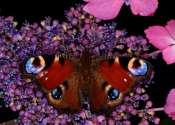Hyperspectral microscopy reveals the nanostructures that give butterflies their colors
Scientists have found a new way to see how butterflies develop their colors.
Journal of the Royal Society Interface welcomes articles of high quality research at the interface of the physical and life sciences. It provides a high-quality forum to publish rapidly and interact across this boundary in two main ways: J. R. Soc. Interface publishes research applying chemistry, engineering, materials science, mathematics and physics to the biological and medical sciences; it also highlights discoveries in the life sciences of relevance to the physical sciences. Both sides of the interface are considered equally and it is one of the only journals to cover this exciting new territory. J. R. Soc. Interface welcomes contributions on a diverse range of topics, including but not limited to; biocomplexity, bioengineering, bioinformatics, biomaterials, biomechanics, bionanoscience, biophysics, chemical biology, computer science (as applied to the life sciences), medical physics, synthetic biology, systems biology, theoretical biology and tissue engineering.

Scientists have found a new way to see how butterflies develop their colors.
Bio & Medicine
Sep 11, 2024
0
89

Since the end of the last Ice Age, growth of the human population has been far from uniform, marked instead by periods of rapid expansion followed by sharp declines. The reasons behind these fluctuations remain only partially ...
Archaeology
Aug 28, 2024
0
94

A team of economic and business researchers from Southeast University, in China, University College London and Queen Mary University of London in the U.K. has found what they describe as the academic equivalent of a Great ...

The prevalence of ticks in Scotland will increase by a quarter under the most optimistic climate change scenario, according to new modeling by mathematicians at the University of Stirling.
Plants & Animals
Aug 7, 2024
0
117

A team of engineers and zoologists affiliated with several institutions in Japan has developed a new way to study riblet denticles on shark skin. In their study, published in the Journal of the Royal Society Interface, the ...

Butterflies and moths collect so much static electricity while in flight, that pollen grains from flowers can be pulled by static electricity across air gaps of several millimeters or centimeters.
Plants & Animals
Jul 23, 2024
1
571

A team of environmental engineers and city planners from University College London, the University of Sydney, and École Polytechnique Fédérale de Lausanne has discovered that cities grow in ways similar to the development ...

According to the Gaia hypothesis, which was proposed by the scientists Lovelock and Margulis in the 1970s, our planet should have been getting progressively warmer for millions of years, while our oceans should have been ...
Planetary Sciences
Feb 15, 2024
0
56

A small team of botanists, biologists and natural scientists affiliated with several institutions in Germany has found that European alder spittlebug nymphs protect themselves with a coat of bubbles they generate themselves. ...

Underwater surfaces can get grimy as they accumulate dirt, algae and bacteria, a process scientists call "fouling." But furry mammals like beavers and otters that spend most of their lives wet manage to avoid getting their ...
Plants & Animals
Jan 11, 2024
2
444